Update May, 2019
To create a new password on your iPhone or iPad follow the steps below. Open Settings and go to Notes. On the Notes screen tap on Password and then on ‘Reset Password' option. Enter your Apple ID password and then tap on ‘Reset Password' option. Enter the Password and add a hint for your new password. The listing under Account Information does not have an opportunity to change the password. (It lists Description, Alias, email address, Full Name, Incoming Mail Server grayed out, Username grayed out, Outgoing Mail Server SMTP and TLS Certificate) Under the other sub-tabs (Mailbox Behaviors and Advanced) also no opportunity to update or enter a. On your Mac, choose Apple menu Restart, or press the Power button on your computer and then click Restart. Click your user account, click the question mark in the password field, then click the arrow next to 'reset it using your Apple ID.' Enter an Apple ID and password, then click Next. Follow the instructions to reset your login password.
Now that there are SecureToken users, the command below no longer works to reset another user's password. Thanks to mario on the MacAdmins Slack for testing.
Acknowledgements

Just a cleaned-up version of directions from Mac Script to change Administrator password
Changing a user password via terminal command
If you ever want to—perhaps for scripting purposes?—change a user's password from the command-line (despite what it says in the link above, you don't have to be logged in as the user to change the user's password, but you do have to be logged in as an admin user), these are the commands you'd use:
sudo security set-keychain-password -o oldpassword -p newpassword /Users/username/Library/Keychains/login.keychain
If you don't know the old password...
If, for some reason, you (and the user both) have forgotten the user's old password and don't want to deal with keychains issues, you can also just delete the existing keychain (instead of running the second command to update the keychain password):
Security issues
How To Change The Password For Mac Catalina
One strong caveat is that the terminal, by default, will save commands to ~/.bash_history in plain text, so you're essentially storing a user's password in plain text, unless you temporarily disable bash history or later go into the ~/.bash_history file with a text editor (like nano) and delete the offending lines manually.
If you distribute this as part of a .pkg, nothing will be visible in a .bash_history file, but make sure you keep that .pkg extra secure or delete it after deploying it.
Related
Update May, 2019
Now that there are SecureToken users, the command below no longer works to reset another user's password. Thanks to mario on the MacAdmins Slack for testing.
Acknowledgements
Just a cleaned-up version of directions from Mac Script to change Administrator password
Changing a user password via terminal command
If you ever want to—perhaps for scripting purposes?—change a user's password from the command-line (despite what it says in the link above, you don't have to be logged in as the user to change the user's password, but you do have to be logged in as an admin user), these are the commands you'd use:
sudo security set-keychain-password -o oldpassword -p newpassword /Users/username/Library/Keychains/login.keychain
If you don't know the old password...
How To Change Password For Mac User
If, for some reason, you (and the user both) have forgotten the user's old password and don't want to deal with keychains issues, you can also just delete the existing keychain (instead of running the second command to update the keychain password):
Security issues
One strong caveat is that the terminal, by default, will save commands to ~/.bash_history in plain text, so you're essentially storing a user's password in plain text, unless you temporarily disable bash history or later go into the ~/.bash_history file with a text editor (like nano) and delete the offending lines manually.
If you distribute this as part of a .pkg, nothing will be visible in a .bash_history file, but make sure you keep that .pkg extra secure or delete it after deploying it.

